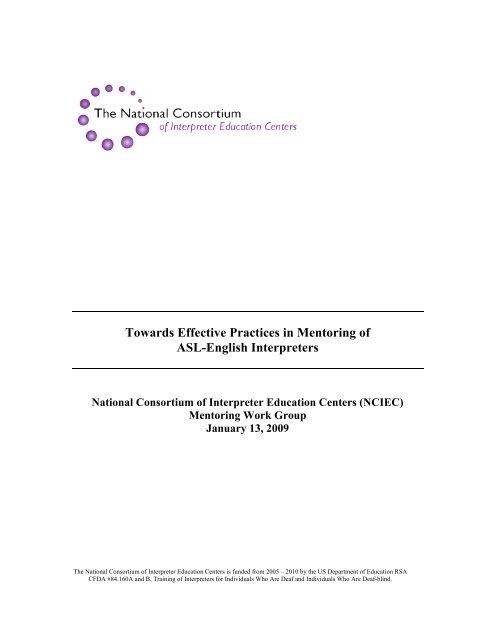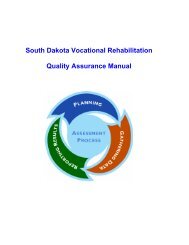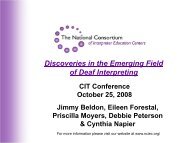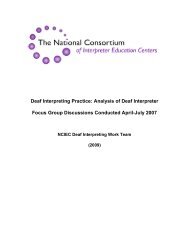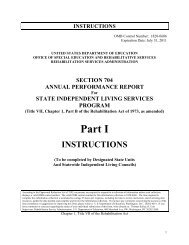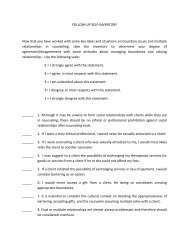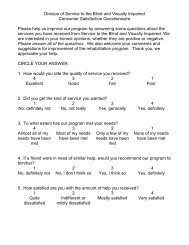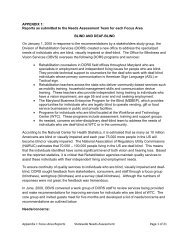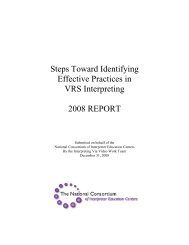Towards Effective Practices In Mentoring Of ASL ? English
Towards Effective Practices In Mentoring Of ASL ? English
Towards Effective Practices In Mentoring Of ASL ? English
You also want an ePaper? Increase the reach of your titles
YUMPU automatically turns print PDFs into web optimized ePapers that Google loves.
<strong>Towards</strong> <strong>Effective</strong> <strong>Practices</strong> in <strong>Mentoring</strong> of<br />
<strong>ASL</strong>-<strong>English</strong> <strong>In</strong>terpreters<br />
National Consortium of <strong>In</strong>terpreter Education Centers (NCIEC)<br />
<strong>Mentoring</strong> Work Group<br />
January 13, 2009<br />
The National Consortium of <strong>In</strong>terpreter Education Centers is funded from 2005 – 2010 by the US Department of Education RSA<br />
CFDA #84.160A and B, Training of <strong>In</strong>terpreters for <strong>In</strong>dividuals Who Are Deaf and <strong>In</strong>dividuals Who Are Deaf-blind.
<strong>In</strong>troduction<br />
It has been said that a tree planted in an old forest will grow stronger than a tree planted<br />
in an open field. This is because the roots of a tree are able to follow the pathways<br />
formed by other trees and therefore, embed themselves more deeply. These pathways<br />
can even allow roots of several trees to connect, resulting in an interdependent weave that<br />
makes the forest stronger overall. This aspect of nature is like the mentoring process—<br />
humans also thrive best when they can grow in the presence of those who have gone<br />
before.<br />
There have always been mentors—but our ability to name them is relatively recent.<br />
Psychologists discovered them only a generation ago; educators and the business world<br />
were not far behind. Since then, mentors and mentoring have become a common<br />
reference in discourse centering on career and professional development. This is<br />
certainly true in the field of <strong>ASL</strong>-<strong>English</strong> interpreting and interpreter education—<br />
mentoring has evolved into the most common approach to inducting new practitioners<br />
into the fields and orienting experienced practitioners into areas of specialization.<br />
Over the years, the objective of the mentoring relationship has evolved into practices<br />
rooted in adult learning. As a result, the mentor is an individual skilled in the ability to<br />
facilitate a learning relationship—rather than just transfer knowledge. As well, the<br />
mentee is an active participant in the mentoring process—planning how and what they<br />
will learn. There is substantial literature about the ensuing relationship and how it<br />
unfolds and is managed, including the Master Mentor Curriculum available online<br />
through http://www.asl.neu.edu/TIEM.online/mm_curriculum.html.<br />
_<br />
What is lacking in the current literature from the field of interpreting is evidence of what<br />
constitutes effective mentoring in terms of yielding improved performance of interpreting<br />
practitioners. As a result, the focus of this document is to identify the promising, best,<br />
and effective practices for establishing and implementing mentoring programs, so that<br />
empirical results can be determined. With the proliferation of mentoring efforts in recent<br />
years, defining a system in which the benefit of mentoring can be evaluated and<br />
documented is of central importance.<br />
Definitions<br />
Standard Practice: common practice. RID states that standard practice papers articulate<br />
the consensus of the membership in outlining standard practices and positions on various<br />
interpreting roles and issues.<br />
Best Practice: research-verified or based on prior research literature or followed by<br />
exemplary institutions. It is also defined as a technique or methodology that, through<br />
experience and research, has proven to reliably lead to a desired result.<br />
www.nciec.org 2
<strong>Effective</strong> Practice: Only practice verified by research as yielding target outcomes (more<br />
than 1-2 studies).<br />
Process<br />
<strong>In</strong> preparing this document, a literature review was conducted—a summary of which is<br />
provided at the end of the document. The review included articles from the RID Journal,<br />
RID convention proceedings, RID Views, CIT convention proceedings, the Project TIEM<br />
Master Mentor Program curriculum, textbooks relating to the field of interpreting and<br />
interpreter education, and the Standard <strong>Practices</strong> papers published by the RID. <strong>Of</strong><br />
particular interest was the reporting of mentoring projects funded in part or whole by the<br />
RID during the past 6-8 years, as well as the results of national surveys collected from<br />
mentors and mentees. Reports can be found at<br />
http://www.nciec.org/projects/mentor_epresearch.html.<br />
Findings<br />
Approach 1: Elements of the following ten standards of best/promising practice<br />
emerged throughout the literature and can serve as a guide for developing a quality<br />
mentoring program. Though many mentoring efforts do not begin with all ten<br />
best/promising practices fully in place, these standards correlate with those programs that<br />
achieve positive results for American Sign Language-<strong>English</strong> interpreters.<br />
1. A statement of purpose and long-range plan that includes:<br />
• who, what, where, why and how activities will be performed<br />
• input from various stakeholders<br />
• assessment of community need<br />
• realistic, attainable, and easy-to-understand plan of operations<br />
• goals, objectives, and timelines for all aspects of the plan<br />
• funding and resource development plan<br />
2. A recruitment plan for both mentors and participants that includes:<br />
• a portrayal of accurate expectations and benefits<br />
• on-going marketing and public relations<br />
• targeted outreach based on participants' needs<br />
• a basis in the program's statement of purpose and long-range plan<br />
3. An orientation for mentors and participants that includes:<br />
• program overview<br />
• description of eligibility, screening process, and suitability requirements<br />
• level of commitment expected (time, energy, flexibility)<br />
• expectations and restrictions (accountability)<br />
• benefits and rewards participants can expect<br />
www.nciec.org 3
• a separate focus for potential mentors and participants<br />
• a summary of program policies, including:<br />
o written reports<br />
o taped work exchanges<br />
o equipment requirements<br />
o frequency of contact<br />
o evaluation<br />
o reimbursement<br />
4. Eligibility screening for mentors and participants that includes:<br />
• an application process and review<br />
• an interview<br />
• reference checks for mentors, which may include character references and<br />
background checks<br />
• suitability criteria that relate to the program statement of purpose and needs of the<br />
target population, which may include:<br />
o personality profile<br />
o skills identification<br />
o prior teaching and/or mentoring experience<br />
o gender, age, language and cultural/diversity requirements<br />
o level of education<br />
o successful completion of training and orientation<br />
5. A readiness and training curriculum for all mentors and participants that<br />
includes:<br />
• qualified faculty or trainers implementing the curriculum<br />
• orientation to the program and resource network, including information and<br />
referral, and other support services<br />
• models of skills development and assessment (discourse analysis, self-assessment,<br />
etc.)<br />
• models of decision-making (demand-control schema, etc.)<br />
• cultural/heritage sensitivity and appreciation training<br />
• guidelines for participants on how to get the most out of the mentoring<br />
relationship<br />
• do's and don'ts of relationship management<br />
• role descriptions<br />
• confidentiality and liability information<br />
• crisis management/problem solving resources<br />
• communication skills development<br />
• ongoing sessions as necessary<br />
6. A matching strategy that includes:<br />
• a link with the program's statement of purpose<br />
• a commitment to consistency<br />
www.nciec.org 4
• a grounding in the program's eligibility criteria<br />
• a rationale for the selection of this particular matching strategy from the wide<br />
range of available models<br />
• appropriate criteria for matches, including some or all of the following: gender,<br />
age, language requirements, availability, needs, interests, preferences of volunteer<br />
and participant, life experience, temperament<br />
• a signed statement of understanding that both parties agree to the conditions of the<br />
match and the mentoring relationship<br />
7. A monitoring process that includes:<br />
• consistent, scheduled meetings between mentors and participants<br />
• a tracking system for ongoing assessment<br />
• written records<br />
• input from community partners and other stakeholders<br />
• a process for managing grievances, praise, re-matching, interpersonal problem<br />
solving, and early relationship closure<br />
8. A support, recognition, and retention component that includes:<br />
• a formal kick-off event<br />
• ongoing peer support groups for mentors and participants<br />
• ongoing training and development as issues emerge<br />
• relevant issue discussion and information dissemination<br />
• networking with appropriate organizations<br />
9. Closure steps that include:<br />
• exit interviews to debrief the mentoring relationship<br />
• clearly stated policy for future contacts<br />
• assistance for participants in defining next steps for achieving personal goals<br />
10. An evaluation process based on:<br />
• Measurement of effectiveness<br />
o What difference did it make to the Mentee, their goals, consumers of<br />
interpreting services, the field, and the funding source?<br />
• Strategy for ongoing evaluation of the program and application of lessons learned.<br />
• Consideration of the information needs of the program's stakeholders.<br />
• Sharing of program information and lessons learned with program stakeholders<br />
and the broader mentoring/professional community.<br />
Approach 2: Based on a review of the existing literature, the following domains and<br />
associated best practices were identified from the field.<br />
www.nciec.org 5
Domain 1: Program Design and Planning<br />
Domain 2: Program Management<br />
Domain 3: Program Operations<br />
Domain 4: Program Evaluation<br />
Domain 1: Program Design and Planning<br />
1.1 Best Practice: Design the parameters for the program:<br />
• Define the population that the program will serve;<br />
• Identify the types of individuals who will be recruited as mentors;<br />
• Determine the type of mentoring that the program will offer (one-to-one, group,<br />
team, peer or e-mentoring, distance, blended);<br />
• Structure the mentoring program - as a stand-alone program or as part of an<br />
existing organization;<br />
• Define the nature of the mentoring sessions (such as skills or knowledge based,<br />
leadership development, induction);<br />
• Determine what the program will accomplish and what outcomes will result for<br />
the participants, including mentors, mentees and sponsoring organizations;<br />
• Determine when the mentoring will take place;<br />
• Determine how often mentors and mentees will meet and how long the mentoring<br />
matches should last;<br />
• Decide where mentoring matches primarily will meet (workplace, school,<br />
community setting or virtual community);<br />
• Decide who are program stakeholders and how to promote the program;<br />
• Decide how to evaluate program success; and<br />
• Establish case management protocol to assure that the program has regular<br />
contact with both mentors and mentees concerning their relationship.<br />
1.2 Best Practice: Develop a Financial Plan:<br />
• Develop a program budget;<br />
• Determine the amount of funding needed to start and sustain the program<br />
• Identify and secure a diversified funding stream needed to start and sustain the<br />
program;<br />
• Determine the amount of time each funding source can be expected to provide<br />
resources;<br />
• Establish internal controls and auditing requirements; and<br />
• Establish a system for managing program finances.<br />
1.2 Best Practice: Implement a structured program:<br />
• Recruit program participants, such as, mentors, mentees and other volunteers;<br />
• Screen potential mentors and mentees;<br />
• Orient and train mentors, mentees and parents/caregivers;<br />
• Match mentors and mentees;<br />
www.nciec.org 6
• Bring mentors and mentees together for mentoring sessions that fall within<br />
program parameters;<br />
• Provide ongoing support, supervision and monitoring of mentoring relationships;<br />
and<br />
• Help mentors and mentees reach successful closure.<br />
1.4 Best Practice: Plan how to evaluate the program:<br />
• Decide on the evaluation design;<br />
• Determine what data will be collected, how it will be collected and the sources of<br />
data;<br />
• Determine the effectiveness of the program process;<br />
• Determine the outcomes for mentors and mentees; and<br />
• Reflect on and disseminate findings.<br />
Domain 2: Program Management<br />
2.1 Best Practice: Ensure the program is well-managed:<br />
• Form a management team:<br />
o Define the teams roles and responsibilities;<br />
o Recruit people with diverse backgrounds to serve on the team; and<br />
o Facilitate the team meetings to improve programming and management.<br />
• Form an advisory group:<br />
o Define the advisory group roles and responsibilities;<br />
o Recruit people with diverse backgrounds to serve on the group; and<br />
o Facilitate the advisory group meetings to improve programming and<br />
management.<br />
2.2 Best Practice: Develop a comprehensive system for managing program<br />
information:<br />
• Manage program finances;<br />
• Maintain personnel records;<br />
o Track program activity, such as, volunteer hours and matches;<br />
o Document mentor/mentee matches;<br />
• Manage risk; and<br />
• Document program evaluation efforts.<br />
2.3 Best Practice: Design a resource development plan that allows for diversified<br />
fundraising:<br />
• Seek in-kind contributions;<br />
• Hold special events;<br />
• Solicit individual donors;<br />
www.nciec.org 7
• Seek corporate donations;<br />
• Apply for funding; and<br />
• Establish fee structure to be paid by mentees.<br />
2.4 Best Practice: Design a system to monitor the program:<br />
• Review policies, procedures and operations on a regular basis;<br />
• Collect program information from mentors, mentees and other participants; and<br />
• Continually assess customer service.<br />
2.5 Develop a marketing plan;<br />
• Gather feedback from all constituents;<br />
• Develop partnerships and collaborations with other organizations; and<br />
• Recognize mentors, mentees, other program participants, funders and<br />
organizations that sponsor mentoring programs.<br />
Domain 3: Program Operations:<br />
3.1 Best Practice: Ensure strong, everyday operations:<br />
3.1.1 Recruit mentors, mentees and other volunteers:<br />
3.1.1.1 Define eligibility for participants, including mentors, mentees and<br />
parents/caregivers;<br />
3.1.1.2 Market the program; and<br />
3.1.1.3 Conduct awareness and information sessions for potential mentors.<br />
3.1.2 Screen potential mentors and mentees:<br />
3.1.2.1 Require written applications;<br />
3.1.2.2 Conduct reference checks, such as, employment record, character reference and<br />
criminal record checks;<br />
3.1.2.3 Conduct interviews; and<br />
3.1.2.4 Hold orientations.<br />
3.2 Best Practice: Orient and train mentors and mentees<br />
3.2.1 Provide an overview of the program;<br />
3.2.2 Clarify roles, responsibilities and expectations;<br />
3.2.3 Provide theoretical foundation and other tools for interaction, and<br />
3.2.4 Discuss how to handle a variety of situations.<br />
3.3 Best Practice: Match mentors and mentees<br />
3.3.1 Use established criteria;<br />
3.3.2 Arrange an introduction between mentors and mentees; and<br />
3.3.3 Ensure mentors, mentees and parents/caregivers understand and agree to the terms<br />
and conditions of program participation.<br />
www.nciec.org 8
3.4 Best Practice: Bring mentors and mentees together for mentoring sessions that<br />
fall within the program parameters:<br />
3.4.1 Provide safe locations and circumstances; and<br />
3.4.2 Provide resources and materials for activities.<br />
3.5 Best Practice: Provide ongoing support, supervision and monitoring of<br />
mentoring relationships<br />
3.5.1 <strong>Of</strong>fer continuing training opportunities for program participants;<br />
3.5.2 Communicate regularly with participants and offer support;<br />
3.5.3 Help mentors and mentees define next steps for achieving mentee goals;<br />
3.5.4 Bring mentors together to share ideas and support.<br />
3.6 Establish a process to manage grievances, resolve issues and offer positive<br />
feedback;<br />
3.6.1 Assist mentors and mentees whose relationship is not working out; and<br />
3.6.2 Assure that appropriate documentation is done on a regular basis.<br />
3.6.3 Actively solicit feedback from mentors and mentees regarding their experiences;<br />
and<br />
3.6.4 Use information to refine program and retain mentors.<br />
3.6.5 Help mentors and mentees reach closure:<br />
• Conduct private, confidential interviews with mentors and mentees; and<br />
• Ensure mentors and mentees understand program policy regarding their meeting<br />
outside the program.<br />
Domain 4: Program Evaluation<br />
4.1 Best Practice: Develop a plan to measure program process<br />
4.1.1 Select indicators of program implementation viability and fidelity, such as,<br />
training hours, meeting frequency and relationship duration; and<br />
4.1.2 Develop a system for collecting and managing specified data.<br />
4.2 Best Practice: Develop a plan to measure expected outcomes<br />
4.2.1 Specify expected outcomes;<br />
4.2.2 Select appropriate instruments to measure outcomes, such as, questionnaires,<br />
surveys and interviews; and<br />
4.2.3 Select and implement an evaluation design.<br />
4.3 Best Practice: Create a process to reflect on and disseminate evaluation findings<br />
4.3.1 Refine the program design and operations based on the findings; and<br />
4.3.2 Develop and deliver reports to program constituents, funders and other<br />
stakeholders<br />
Barriers<br />
www.nciec.org 9
Funding, sustainability, lack of clarity regarding what is part of pre-service (Resnick<br />
article) and what is part of induction, etc.<br />
Recommendations<br />
<br />
Possibility of a repository of mentoring practices that conform to the following criteria:<br />
• <strong>In</strong>novation—the practice is inventive or original.<br />
• Replicability—the practice can be implemented in a variety of learning environments.<br />
• Potential impact—the practice would advance the field if many adopted it.<br />
• Supporting documentation—the practice is supported with evidence of effectiveness.<br />
• Scope—the practice explains its relationship with other quality elements.<br />
Literature Review:<br />
Barber-Gonzales, D., Preston, C., & Sanderson, G. (1986). Taking care of interpreters at<br />
California State University Northridge National Center on Deafness. <strong>In</strong> M.<br />
Mc<strong>In</strong>tire (Ed.), Proceedings of the 9 th National Convention of the Registry of<br />
<strong>In</strong>terpreters for the Deaf. Alexandria, VA: RID Publications (pp. 154-159).<br />
A mentorship program used at CSUN is described. It has the purpose of initiating<br />
interpreters into the practice of interpreting at a post-secondary level. The<br />
premise is that interpreters need time and opportunity to grow both in terms of<br />
skills and professionalism. CSUN offers an array of mentoring and evaluation<br />
services, each of which is summarized—all towards the goal of promoting a<br />
highly qualified and collegial workforce.<br />
Clark, T. (1994). Mentorship: A True Course in Collaboration—The RITC Region IX<br />
Mentorship Program. <strong>In</strong> E. Winston (Ed.), Proceedings of the Tenth National<br />
Convention of the Conference of <strong>In</strong>terpreter Trainers. Charlotte, NC: CIT<br />
Publications (pp.129-144).<br />
<strong>In</strong>formal mentorship has laid the foundation for the professional growth of<br />
interpreters since the field’s inception. The RITC Region IX Mentorship Program<br />
has attempted to refine mentorship to serve the large number of newly entering<br />
interpreters who do not have mentors. This paper provides a theoretical and<br />
philosophical base of this fast-growing program, along with the practical aspects<br />
of the mentorship. The training of mentors and the mentorship format, along with<br />
materials used to support mentors, and the computer-based tracking system are<br />
also defined. The program involves both Deaf language mentors and interpreter<br />
mentors.<br />
Dean, R. & Pollard, R. (2005). Consumers and Service <strong>Effective</strong>ness in <strong>In</strong>terpreting<br />
Work: A Practice Profession Approach. <strong>In</strong> Marschark, M., Peterson, R., and<br />
Winston, E. (Eds.), Sign Language <strong>In</strong>terpreting and <strong>In</strong>terpreter Education. NYC,<br />
NY: Oxford University Press (pp.259-282).<br />
www.nciec.org 10
This paper promotes the importance of interpreting research. It provides the<br />
theoretical foundation for viewing interpreting as a practice profession and the use<br />
of Demand-Control (D-C) schema in promoting effective interpreting practice,<br />
evidenced by empirical study. There is preliminary data suggesting that<br />
Observation-Supervision has a positive impact on interpreter trainees, guided by<br />
observation forms and semi-structured supervision sessions led by mentors wellversed<br />
in the application of the D-C schema.<br />
Dean, R. & Pollard, R. (2004). Observation-Supervision in Mental Health <strong>In</strong>terpreter<br />
Training. <strong>In</strong> L. Swabey (Ed.), Proceedings of the 14 th National Convention of the<br />
Conference of <strong>In</strong>terpreter Trainers. St. Paul, MN: CIT Publications (pp. 55-76).<br />
A project was conducted with mental health interpreters in four cities across the<br />
United States utilizing observation-supervision methodology. The observationsupervision<br />
training methodology proposes better outcomes in setting-specific<br />
training by allowing interpreters to observe the dynamics and nuances of work<br />
settings, without the constraining presence of deaf consumers or working<br />
interpreters, in a structured manner followed by expert interpreter supervision.<br />
The term ‘supervision’ in this context does not refer to oversight, but rather<br />
discussions between practicing professionals aimed at furthering the effectiveness<br />
of one of the professional’s work.<br />
Earwood, C. (1983). Providing for Comprehensive Practicum Supervision. <strong>In</strong> M.<br />
Mc<strong>In</strong>tire (Ed.), Proceedings of the Fourth National Conference of <strong>In</strong>terpreter<br />
Trainers Convention. Asilomar Conference Center: CIT Publications (pp. 251-<br />
279).<br />
<strong>In</strong> supporting interpreter education students during their field experience, the<br />
mentoring/supervising personnel have a very important role. This article details<br />
the roles and responsibilities of both the mentor/supervisor of the field experience,<br />
as well as the role and responsibilities of the student. The role of mentor and<br />
supervisor are used interchangeably to refer to the individual who have oversight<br />
for the practicum experience, including direct-observation and feedback at least<br />
twice a week, and completion of other procedural activities required by the<br />
policies of the college where the interpreter education program is housed. A<br />
variety of resources are defined which support the program—including a Critique<br />
Manual to be followed by the mentors/supervisors in providing feedback to<br />
students.<br />
Eighinger, L. (2001). Keeping PACE: Performance Assessment for Career Enhancement.<br />
<strong>In</strong> C. Nettles (Ed.), Proceedings of the 17 th National Conference of the Registry<br />
of <strong>In</strong>terpreters for the Deaf. Alexandria, VA: RID Publications (pp. 37-50).<br />
The author offers the rationale for establishing professional development<br />
programming based on careful planning and evaluation, and guided by qualified<br />
mentors. Such an approach will result in true cost effectiveness and the actual<br />
benefits (such as employee retention and enhanced work performance) that should<br />
www.nciec.org 11
come from the investment of time and money. Such programs should be<br />
structured with clearly defined goals and system of evaluation, versus the<br />
common practice of interpreters seizing every opportunity within grasp. The<br />
system described by the author would result in support from three different types<br />
of mentors: a deaf language mentor, an interpreter mentor, and a professional<br />
mentor. Each mentor should be one who has completed training and has<br />
sufficient experience.<br />
Frishberg, N. (1994). Entry Level to the Profession: Response Paper #4- <strong>In</strong>ternship,<br />
Practicum, Fieldwork and <strong>Mentoring</strong>. <strong>In</strong> E. Winston (Ed.), Proceedings of the<br />
Tenth National Convention of the Conference of <strong>In</strong>terpreter Trainers. Charlotte,<br />
NC: CIT Publications (pp.71-74).<br />
This paper expands on an aspect of the gap between formal education and<br />
‘readiness to work’ by summarizing writings on mentoring, as well as some of the<br />
pre-service instantiations of the same general idea, and offers questions about how<br />
mentoring might fit into interpreter education and program standards.<br />
Gunter, D. & Hull, D. (1995). Mentorship Essentials. <strong>In</strong> Swartz, D. (Ed.), Proceedings of<br />
the Fourteenth National Convention of the Registry of <strong>In</strong>terpreters for the Deaf.<br />
Alexandria, VA: RID Publications (pp. 111-115).<br />
A professional mentoring program was developed and implemented by Sign<br />
Shares—an interpreting business in Houston, Texas. The program places<br />
interpreters with minimal experience with more seasoned professionals on reallife<br />
interpreting assignments. The goal of the program is to increase the quantity<br />
and quality of professionally trained interpreters available for community work.<br />
The program provides opportunities for one-on-one mentoring with immediate<br />
and situation-specific feedback.<br />
Hearn, D. & Moore, J. (2006). The Mentor Training Project: Concurrent Learning via<br />
Technology. <strong>In</strong> E. Maroney (Ed.), Proceedings of the 16 th National Convention of<br />
the Conference of <strong>In</strong>terpreter Trainers (pp.149-166).<br />
A pilot Mentor Training Project (MTP) was conducted using distance education<br />
technology to improve the quality of mentoring provided by professional<br />
interpreters to interpreting interns in a college based interpreter education<br />
program. Mentors in the project were working interpreters with varying years of<br />
experience in interpreting and mentoring. The MTP included exploration and<br />
discussion of adult learning theories, general mentoring, and information specific<br />
to signed language interpreting. Mentors had the opportunity to interact online<br />
with second-year interpreting students and to practice giving them feedback on<br />
their work.<br />
Johnson, L. & Winston, B. (1998). You Can’t Teach <strong>In</strong>terpreting At a Distance (And<br />
Other Myths of a Fading Century). <strong>In</strong> J. Alvarez (Ed.), Proceedings of the Twelfth<br />
www.nciec.org 12
National Convention of the Conference of <strong>In</strong>terpreter Trainers. Salt Lake City,<br />
UT: CIT Publications (pp. 109-136).<br />
A distance delivered program for interpreters working in a K-12 setting is<br />
delineated, with attention given to the design of the curriculum, interpreting<br />
competencies, and technologies involved in delivery. The curriculum is<br />
organized into knowledge based courses and skill development courses. The skill<br />
development coursework is offered both onsite and via distance technologies.<br />
Mentors are the primary staff in the implementation of the skills coursework and<br />
engage students in translation and interpreting activities, videotaping of<br />
performance, self-assessment and mentor review, modeling and feedback.<br />
Johnson, L. & Witter-Merithew, A. (2004). <strong>In</strong>terpreting Skills Acquired at a Distance:<br />
Results of a Data-Driven Study. <strong>In</strong> D. Watson (Ed.), Journal of <strong>In</strong>terpretation.<br />
Alexandria, VA: RID Publications (pp. 95-119).<br />
The results of a 2-year mentorship program for improving skills performance of<br />
interpreters working in the K-12 setting are reported. Students of the program<br />
were administered the EIPA as both a pre and post assessment tool. The results<br />
indicate that as a result of one year deaf language mentorship and one year<br />
interpreting mentorship, students of the Educational <strong>In</strong>terpreter Certificate<br />
Program increased their performance on the EIPA by approximately one full<br />
scale.<br />
Maroney, E., Freeburg, J. & Gish, S. (1998). <strong>Effective</strong> <strong>In</strong>-Service for Rural and Remote<br />
Educational <strong>In</strong>terpreters. <strong>In</strong> J. Alvarez (Ed.), Proceedings of the Twelfth National<br />
Convention of the Conference of <strong>In</strong>terpreter Trainers. Salt Lake City, UT: CIT<br />
Publications (pp. 109-136).<br />
A Summer <strong>In</strong>terpreter Education Program (SIEP) was developed and<br />
implemented at Western Oregon University to address the professional<br />
development needs of interpreters working in K-12 settings in rural and remote<br />
locations. The program has three objectives—one of which is to prepare lead<br />
interpreters to become interpreter resource specialists and mentors. These<br />
participants are trained to offer individualized evaluation, training and support to<br />
staff interpreters in their respective school districts throughout the school year.<br />
Training for this group includes theoretical models of interpreting, tasks<br />
associated with interpreting, philosophy and methodology associated with various<br />
interpretation assessment/evaluation strategies, and materials, activities and<br />
curricula that can be used for providing training and evaluation.<br />
Napier, J. (2006). The New Kid on the Block: <strong>Mentoring</strong> Sign Language <strong>In</strong>terpreters in<br />
Australia. <strong>In</strong> Watson, D. (Ed.), Journal of <strong>In</strong>terpretation. Alexandria, VA: RID<br />
Publications (pp. 25-46).<br />
A critique of literature on mentoring and sign language interpreting is provided,<br />
and the author proposes six key phases of mentoring for sign language<br />
www.nciec.org 13
interpreters. The six phases are: 1) developing a mentoring plan, 2) preparing for<br />
interpreting assignments, 3) joint interpreting assignments, 4) supervised<br />
interpreting assignments, 5) analysis of recorded interpreting material, and 6)<br />
developing a portfolio. The paper also discusses why a mentoring system has not<br />
yet been successfully established in Australia, and gives some recommendations<br />
for implementing mentoring for Auslan interpreters, with acknowledgement of<br />
potential barriers.<br />
Nishimura, J., Bridges, B., & Owen-Beckford, J. (1995). <strong>Mentoring</strong> and Evaluation<br />
Sampler. <strong>In</strong> Swartz, D. (Ed.), Proceedings of the Fourteenth National Convention<br />
of the Registry of <strong>In</strong>terpreters for the Deaf. Alexandria, VA: RID Publications<br />
(pp. 164-176).<br />
A large interpreter coordination agency, Sign Language Associates (SLA), which<br />
employs a significant number of part and full time interpreters for a wide range of<br />
settings, reports on an innovative mentorship program. Due to the gap in job<br />
readiness of newly entering practitioners, SLA determined the need to establish a<br />
mentorship program. This paper details the structure and implementation of the<br />
program—which is now international scope. The paper defines mentorship as a<br />
learning relationship between an interpreter and a more experienced interpreter<br />
that focuses on defined professional development goals.<br />
Project TIEM. Online (2004). Master Mentor Curriculum. Available:<br />
http://www.asl.neu.edu/tiem.online/mastermentor.html<br />
A sequence of four courses that comprise a curriculum designed to prepare<br />
individuals to serve as interpreting mentors and leaders within their communities.<br />
The document provides information on the principles followed in designing and<br />
developing the Master Mentor Program at Northeastern University, as well as<br />
detailed information on the program itself. It is designed to help others understand<br />
the philosophy underlying the approach and to offer the curriculum through their<br />
own institutions.<br />
Resnick, S. (1990). The Skill Gap: Is <strong>Mentoring</strong> the Answer? <strong>In</strong> Swabey, L. (Ed.),<br />
Proceedings of the 8 th National Convention of the Conference of <strong>In</strong>terpreter<br />
Trainers. Pomona, CA: CIT Publications (pp. 131-140).<br />
<strong>In</strong> order to determine if mentoring is the answering to closing the skill gap, two<br />
basic questions must be answered. What is the nature of the gap and what is the<br />
best way to address it? The author discusses conceptualizations of mentoring and<br />
defines other formats—such as extended practica, apprenticeships, internships and<br />
individualized tutoring/remediation. Each format is discussed and its limits<br />
explored, followed by some recommendations about how mentoring and each of<br />
these other formats might be included a part of the comprehensive design of<br />
interpreter education programs.<br />
www.nciec.org 14
Shaffer, L. & Watson, W. (2004). Peer <strong>Mentoring</strong>: What is THAT? <strong>In</strong> L. Swabey (Ed.),<br />
Proceedings of the 14 th National Convention of the Conference of <strong>In</strong>terpreter<br />
Trainers. St. Paul, MN: CIT Publications (pp. 77-92).<br />
A program template designed to support a peer mentoring program, and outlining<br />
the seven guiding principles of the program is detailed. The Peer <strong>Mentoring</strong><br />
Model (PMM) was designed in an effort to address the diverse needs of<br />
interpreters—geographically, ethnically/culturally, and progress towards<br />
credentialing. The goal is to support individual skill and career development, as<br />
well as to create a community of learning that could be utilized for continued<br />
professional evolution. The guiding principles are: 1) permission, 2)<br />
accountability, 3) listening, 4) authenticity, 5) ‘walk the walk’, 6) shared context<br />
and 7) separation of self from the work.<br />
Wiesman, L. & Forestal, E. (2006). <strong>Effective</strong> <strong>Practices</strong> for Establishing <strong>Mentoring</strong><br />
Programs. <strong>In</strong> E. Maroney (Ed.), Proceedings of the 16 th National Convention of<br />
the Conference of <strong>In</strong>terpreter Trainers (pp.193-208).<br />
The authors discuss various options for developing mentoring projects. Specific<br />
emphasis is on effective practices for providing individual program training to<br />
participants, ideal organizational structure of training, participants and<br />
presentation curriculum. The authors define mentorship as an interdependent,<br />
collaborative relationship formed with the intention of professional development<br />
for one or more participants. The discussion focuses on the philosophical<br />
framework for the design of mentoring programs, which is based on socialconstructivist<br />
theory, as well as mentor program evaluation considerations.<br />
Winston, E. (2006). <strong>Effective</strong> <strong>Practices</strong> in <strong>Mentoring</strong>: Closing the Gap and Easing the<br />
Transition. <strong>In</strong> E. Maroney (Ed.), Proceedings of the 16 th National Convention of<br />
the Conference of <strong>In</strong>terpreter Trainers (pp.183-192).<br />
The National Consortium of <strong>In</strong>terpreter Education Programs mentoring work<br />
group is conducting several inter-related mentoring activities that 1) identify<br />
current and/or potentially promising practices; 2) evaluate them for effectiveness<br />
in mentoring; and 3) implement them appropriately across the United States. The<br />
sources for collecting information about current or promising practices are<br />
discussed—with particular attention given to the RID’s Standard Practice Paper,<br />
NCIEC Mentor and Mentee surveys, and NCIEC Focus Groups. One national<br />
focus group was convened and continues its work online, discussing existing<br />
practices, identifying practices that appear effective, and some emerging<br />
definitions of what mentoring is and is not.<br />
Witter-Merithew, A., Taylor, M. & Johnson, L. (2001). Guided Self-Assessment and<br />
Professional Development Planning: A Model Applied to <strong>In</strong>terpreters in<br />
Educational Settings. <strong>In</strong> C. Nettles (Ed.), Proceedings of the 17<br />
www.nciec.org 15<br />
th National<br />
Conference of the Registry of <strong>In</strong>terpreters for the Deaf. Alexandria, VA: RID<br />
Publications (pp. 153-226).
An academic course of study for educational interpreters involving two-years of<br />
mentorship—one year with a deaf language mentor and one year with an<br />
interpreting mentor—is detailed. The mentoring process engages students in<br />
performance self-assessment and reflection, with additional feedback and<br />
modeling provided by the mentor. The process involves both in-person<br />
interactions for creating a shared foundation, followed by distance delivered<br />
exchanges of work supported by online discussion. Mentors are trained and<br />
supervised by instructional managers who provide support to mentors in<br />
improving their performance, resulting in a complete cycle of support.<br />
Witter-Merithew, A., Johnson, L., Bonni, B., Naiman, R., and Taylor, M. (2002). Deaf<br />
Language Mentors: A Model of Mentorship via Distance Delivery. <strong>In</strong> L. Swabey<br />
(Ed.), Proceedings of the 14 th National Convention of the Conference of<br />
<strong>In</strong>terpreter Trainers. St. Paul, MN: CIT Publications (pp. 33-52).<br />
This paper details a year-long language mentorship program implemented by deaf<br />
individuals working with interpreters in the K-12 setting. The program is part of<br />
an academic course of study and involves a combination of an intensive threeweek<br />
onsite instruction to establish a common foundation, followed by a year<br />
long exchange of language samples supported by online discussions. Mentors are<br />
trained and participate in a structured forum of support and sharing. Empirical<br />
evidence shows that this program contributes to an increase in performance of one<br />
full scale on the EIPA.<br />
Zachary, L. (2000). The Mentor’s Guide: Facilitating <strong>Effective</strong> Learning Relationships.<br />
San Francisco, CA: Jossey-Bass.<br />
The mentor’s key tasks and processes for enhancing learning are described in<br />
detail. The theoretical foundation is based on Daloz’s learner-centered focus, and<br />
by focusing on the learner and the learning connection, and the learning process,<br />
defines the very core of mentoring. It is a text that presents an array of practical<br />
options, steps, and strategies for action and reflection and is useful in a variety of<br />
settings to help facilitate the mentee’s learning.<br />
RID Views Literature Review:<br />
Clark, T. (1993). Views from a Mentee. RID Views. Vol. 16 (10):9.<br />
Gordon, P. (2005). The Play’s the Thing: a Dramatic Approach to <strong>Mentoring</strong> (Part III).<br />
RID Views. Vol. 22 (11). 24-25.<br />
Hayes, L. (1993). <strong>Mentoring</strong>: Formalizing a Unique Part of RID History. RID Views.<br />
Vol. 16 (10). 1f.<br />
www.nciec.org 16
Huber, M. (1993). Birth of a Mentor at the National Center on Deafness. RID Views. Vol.<br />
16 (10):6.<br />
Hull, D. (1993). Sign Shares <strong>In</strong>ternship Pilot Project is a Shining Success. RID Views.<br />
Vol. 16 (10). 1f.<br />
Johnson, M. (1993). <strong>Mentoring</strong>: From the Mentee’s Perspective. RID Views. Vol. 16<br />
(10): 6.<br />
Julander, J. (2001). Utah’s <strong>Mentoring</strong> Program. RID Views. Vol. 18 (1): 36.<br />
Nishimura, J. (1993). Addressing Professional Development and Staff: Sign Language<br />
Associates’ Mentorship Program. RID Views. Vol. 16 (10): 11.<br />
Preston, C. (1993). Mentorship at the National Center on Deafness. RID Views. Vol. 16<br />
(10): 6.<br />
Senter, E. (1993). <strong>Mentoring</strong>: Next to Ideal. RID Views. Vol. 16 (10): 3f.<br />
Willig, P. (1993). How to determine your mentorship needs. RID Views. Vol. 16 (10): 13.<br />
<br />
<br />
<br />
<br />
<br />
<br />
<br />
<br />
<br />
<br />
<br />
<br />
<br />
<br />
www.nciec.org 17
<br />
<br />
<br />
<br />
<br />
<br />
<br />
<br />
<br />
<br />
<br />
<br />
<br />
<br />
© National Consortium of <strong>In</strong>terpreter Education Centers <br />
CATIE Center at St. Catherine University <br />
Gallaudet University Regional <strong>In</strong>terpreter Education Center<br />
Mid-America Regional <strong>In</strong>terpreter Education Center at University of Arkansas at<br />
Little Rock<br />
National <strong>In</strong>terpreter Education Center at Northeastern University<br />
Regional <strong>In</strong>terpreter Education Center at Northeastern University<br />
Western Region <strong>In</strong>terpreter Education Center at Western Oregon University<br />
The National Consortium of <strong>In</strong>terpreter Education Centers is funded from 2005 – 2010<br />
by the U.S. Department of Education RSA CFDA #84.160A and B, Training of<br />
<strong>In</strong>terpreters for <strong>In</strong>dividuals Who Are Deaf and <strong>In</strong>dividuals Who Are Deaf-Blind.<br />
Permission is granted to copy and disseminate these documents and video materials for<br />
educational purposes, provided that National Consortium of <strong>In</strong>terpreter Education<br />
Centers is credited as the source and referenced appropriately on any such copies.<br />
www.nciec.org 18
www.nciec.org 19


